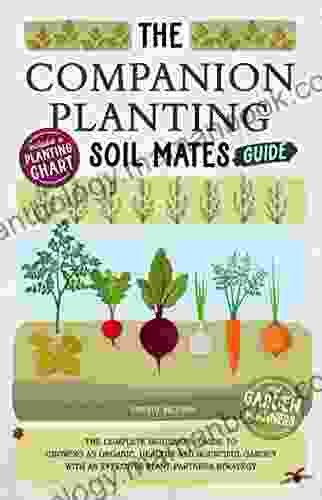The Companion Planting Soil Mates Guide: A Comprehensive Guide to Growing Plants Together for Success

Welcome to the world of companion planting, a technique that has been used for centuries to improve plant growth, health, and yield. Companion planting involves the strategic pairing of compatible plants that benefit each other when grown in close proximity. It's like creating a harmonious ecosystem in your garden, where plants work together to enhance each other's growth and productivity.
4.9 out of 5
| Language | : | English |
| File size | : | 4004 KB |
| Text-to-Speech | : | Enabled |
| Screen Reader | : | Supported |
| Enhanced typesetting | : | Enabled |
| Print length | : | 127 pages |
In this comprehensive guide, we'll dive into the fascinating world of soil mates - plants that form mutually beneficial relationships with each other through their roots. We'll explore the science behind companion planting, uncover the best plant pairings, and provide practical tips to help you implement this technique in your own backyard.
The Science of Companion Planting
The concept of companion planting is rooted in the principle of allelopathy, a process where plants release chemical compounds that can influence the growth of neighboring plants. These compounds can have positive or negative effects, depending on the plant species involved.
When soil mates are paired together, they release beneficial compounds that stimulate growth, protect against pests and diseases, and improve soil health. For example, some plants excrete chemicals that enhance nutrient uptake by their companion plants, while others release compounds that suppress the growth of harmful bacteria and fungi.
Benefits of Companion Planting
The benefits of companion planting are numerous and well-documented. By carefully selecting compatible plants, you can:
- Maximize yield: Some plants, like tomatoes and carrots, grow better together and produce higher yields than when grown alone.
- Improve plant health: Certain plant pairings can help protect companion plants from pests and diseases. For example, marigolds release compounds that repel nematodes, which can damage plant roots.
- Enhance soil health: Some plants, like legumes, fix nitrogen from the air and make it available to neighboring plants.
- Save space: Companion planting allows you to grow more plants in a smaller area by utilizing vertical space and intercropping different species.
- Attract beneficial insects: Many flowers, such as zinnias and sunflowers, attract pollinators and other beneficial insects to your garden, which can improve pollination and reduce pest pressure.
Choosing Compatible Soil Mates
The key to successful companion planting is choosing compatible soil mates. Not all plants are created equal, and some species simply don't play well together. To avoid any potential conflicts, it's essential to research and select plants that have a proven history of beneficial relationships.
Here are some guidelines to help you choose compatible soil mates:
- Consider plant families: Plants from the same family tend to have similar nutrient needs and growth habits, making them good candidates for companion planting. For example, members of the Brassicaceae family, such as broccoli, cabbage, and cauliflower, are known to grow well together.
- Match growth habits: Tall, sprawling plants can shade out smaller, more delicate plants. When pairing plants, consider their height, spread, and root depth to ensure they have adequate space and light.
- Avoid allelopathic plants: Some plants, such as black walnut and eucalyptus, release chemicals that can inhibit the growth of neighboring plants. Avoid planting these species in close proximity to other plants.
- Rotate crops: To prevent soil depletion and disease buildup, it's essential to rotate crops each season. This will help maintain soil health and reduce the risk of pest and disease problems.
Best Plant Pairings for Soil Mates
There are countless plant pairings that can benefit each other when grown together. Here are a few tried-and-true soil mate combinations to get you started:
- Tomatoes + Basil: Basil releases compounds that deter tomato hornworms and other pests. In return, tomatoes provide shade for the basil plants.
- Carrots + Onions: Onions release sulfur compounds that repel carrot flies. Carrots, in turn, improve the flavor of onions.
- Corn + Beans: Beans fix nitrogen from the air and make it available to corn plants. Corn provides support for pole beans.
- Marigolds + Tomatoes: Marigolds release compounds that repel nematodes and other soil-borne pests that can damage tomatoes.
- Lavender + Roses: Lavender attracts beneficial insects and releases a calming scent that helps deter pests from roses.
Tips for Successful Companion Planting
In addition to choosing compatible plants, there are a few practical tips you can follow to ensure success in companion planting:
- Start small: Don't try to plant an entire companion garden overnight. Start with a few carefully selected plant pairings and experiment to see what works best in your climate and soil conditions.
- Prepare your soil: Healthy soil is essential for plant growth. Amend your soil with compost or manure to improve fertility and drainage.
- Plant at the right depth: When planting soil mates, be sure to place them at the appropriate depth to ensure proper root development.
- Water deeply and regularly: Plants grown in companion plantings may need more water than those grown alone. Water deeply and regularly to promote healthy growth.
- Mulch around your plants: A layer of mulch will help retain moisture, suppress weeds, and regulate soil temperature.
- Monitor your plants: Regularly check your plants for signs of distress. If you notice any problems, adjust your planting arrangement or watering schedule as needed.
Companion planting is a time-honored technique that can help you grow healthier, more productive plants while improving soil health and reducing the need for pesticides and fertilizers. By understanding the principles of allelopathy and choosing compatible soil mates, you can create a thriving ecosystem in your garden that will reward you with bountiful harvests for years to come.
So embrace the world of companion planting and unlock the secrets of soil mates. With a little research and experimentation, you can transform your garden into a harmonious and productive haven.
4.9 out of 5
| Language | : | English |
| File size | : | 4004 KB |
| Text-to-Speech | : | Enabled |
| Screen Reader | : | Supported |
| Enhanced typesetting | : | Enabled |
| Print length | : | 127 pages |
Do you want to contribute by writing guest posts on this blog?
Please contact us and send us a resume of previous articles that you have written.
 Top Book
Top Book Novel
Novel Fiction
Fiction Nonfiction
Nonfiction Literature
Literature Paperback
Paperback Hardcover
Hardcover E-book
E-book Audiobook
Audiobook Bestseller
Bestseller Classic
Classic Mystery
Mystery Thriller
Thriller Romance
Romance Fantasy
Fantasy Science Fiction
Science Fiction Biography
Biography Memoir
Memoir Autobiography
Autobiography Poetry
Poetry Drama
Drama Historical Fiction
Historical Fiction Self-help
Self-help Young Adult
Young Adult Childrens Books
Childrens Books Graphic Novel
Graphic Novel Anthology
Anthology Series
Series Encyclopedia
Encyclopedia Reference
Reference Guidebook
Guidebook Textbook
Textbook Workbook
Workbook Journal
Journal Diary
Diary Manuscript
Manuscript Folio
Folio Pulp Fiction
Pulp Fiction Short Stories
Short Stories Fairy Tales
Fairy Tales Fables
Fables Mythology
Mythology Philosophy
Philosophy Religion
Religion Spirituality
Spirituality Essays
Essays Critique
Critique Commentary
Commentary Glossary
Glossary Bibliography
Bibliography Index
Index Table of Contents
Table of Contents Preface
Preface Introduction
Introduction Foreword
Foreword Afterword
Afterword Appendices
Appendices Annotations
Annotations Footnotes
Footnotes Epilogue
Epilogue Prologue
Prologue Tom Robbins
Tom Robbins Cerise Rose
Cerise Rose Maggie Marr
Maggie Marr Jessie Ash
Jessie Ash Kris Bordessa
Kris Bordessa Geoffrey Darnton
Geoffrey Darnton Michael Rubenfeld
Michael Rubenfeld Neal D Barnard
Neal D Barnard Don Nardo
Don Nardo Christiane Prange
Christiane Prange Edited By Donna Farland Smith
Edited By Donna Farland Smith Sinistre Ange
Sinistre Ange Pat Nicholson
Pat Nicholson Lesley Sharpe
Lesley Sharpe Todd Whitaker
Todd Whitaker Jen Silverman
Jen Silverman Mel Starr
Mel Starr April Laugh
April Laugh Marion Zimmer Bradley
Marion Zimmer Bradley Griff Hosker
Griff Hosker
Light bulbAdvertise smarter! Our strategic ad space ensures maximum exposure. Reserve your spot today!

 Henry David ThoreauInvasion Caledonia: The Sword of Cartimandua, Unveiling the Secrets of a...
Henry David ThoreauInvasion Caledonia: The Sword of Cartimandua, Unveiling the Secrets of a...
 Patrick RothfussThe Extraordinary Life of Felonious Monk William Kotzwinkle: A Literary...
Patrick RothfussThe Extraordinary Life of Felonious Monk William Kotzwinkle: A Literary... Tim ReedFollow ·18k
Tim ReedFollow ·18k Felix HayesFollow ·10.7k
Felix HayesFollow ·10.7k Fabian MitchellFollow ·15.7k
Fabian MitchellFollow ·15.7k Isaac AsimovFollow ·9.1k
Isaac AsimovFollow ·9.1k Cody BlairFollow ·15.5k
Cody BlairFollow ·15.5k Rudyard KiplingFollow ·16.9k
Rudyard KiplingFollow ·16.9k Julio Ramón RibeyroFollow ·16.5k
Julio Ramón RibeyroFollow ·16.5k Chandler WardFollow ·8k
Chandler WardFollow ·8k

 Vernon Blair
Vernon BlairThe Woman I Met in My Dream: An Unforgettable Night of...
As the veil of night...

 Carlos Fuentes
Carlos FuentesThe Ultimate Guide to Healthy Eating for Toddlers: Meal...
As a parent of a...

 Peter Carter
Peter CarterInside My Autistic Mind: A Journey of Self-Discovery and...
Autism spectrum disorder (ASD) is a...

 Isaac Asimov
Isaac AsimovA Journey Through Jane Austen's Literary Masterpieces:...
Jane Austen, the renowned English...

 Hank Mitchell
Hank MitchellAdvancements in Textiles: Science and Technology by...
The textile...

 Troy Simmons
Troy SimmonsRecovery Road: An Odyssey of Hope and Redemption by...
Recovery Road is a...
4.9 out of 5
| Language | : | English |
| File size | : | 4004 KB |
| Text-to-Speech | : | Enabled |
| Screen Reader | : | Supported |
| Enhanced typesetting | : | Enabled |
| Print length | : | 127 pages |








